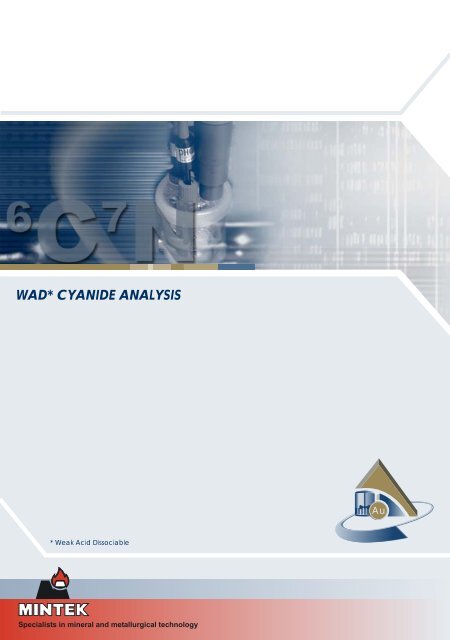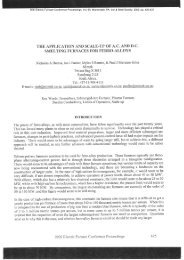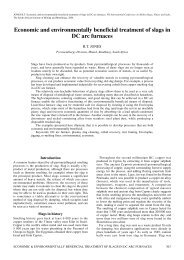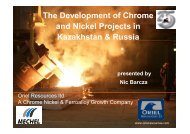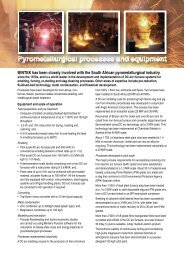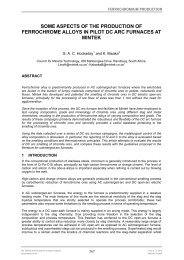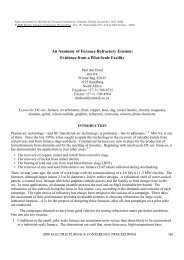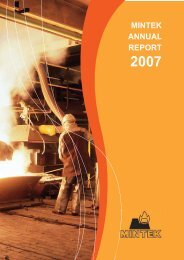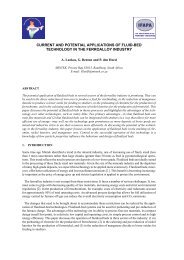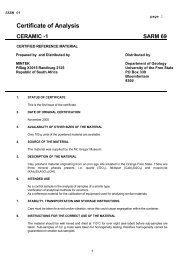WAD* CYANIDE ANALYSIS - Mintek
WAD* CYANIDE ANALYSIS - Mintek
WAD* CYANIDE ANALYSIS - Mintek
You also want an ePaper? Increase the reach of your titles
YUMPU automatically turns print PDFs into web optimized ePapers that Google loves.
<strong>WAD*</strong> <strong>CYANIDE</strong> <strong>ANALYSIS</strong><br />
* Weak Acid Dissociable<br />
Specialists in mineral and metallurgical technology<br />
Au
OVERVIEW<br />
The WAD Cynoprobe is <strong>Mintek</strong>’s state of the art cyanide measurement<br />
instrument. It is based upon the proven technology of <strong>Mintek</strong>’s Cynoprobe<br />
Version 2 Analyser (used to measure ‘free’ (titrateable) cyanide) and<br />
includes additional functionality in that it can measure both ‘free’ and<br />
<strong>WAD*</strong> cyanide concentrations online.<br />
The outputs from the WAD Cynoprobe can be used as follows:<br />
• The ‘free’ cyanide concentration reading can be employed as<br />
part of a cost-saving cyanide management strategy.<br />
• The WAD cyanide reading can be used to control and optimise<br />
the cyanide destruction and recovery process as well as measuring<br />
the WAD cyanide discharge levels from the process.<br />
• The ‘free’ and WAD cyanide outputs can be compared.<br />
The difference between these values give an indication of the<br />
concentration of WAD metals being processed – useful information<br />
when optimising the cyanidation process.<br />
MINTEK has been active in the field of novel instrumentation design,<br />
manufacture and installation for industrial plants world-wide since the<br />
early 1970’s. The Cynoprobe has produced accurate measurement of<br />
‘free’ cyanide concentration on a variety of ore types. The Cynoprobe’s<br />
fast and reliable measurements allow for detection of changes in cyanide<br />
concentration very quickly.<br />
<strong>Mintek</strong>’s broad Cynoprobe install base includes various installations across<br />
Africa, North and South America and Australasia. A reference list is available<br />
on request.<br />
USA<br />
The WAD cynoprobe<br />
Analyser, Processor<br />
and LEX Units.<br />
Mexico<br />
Peru<br />
Ghana<br />
RSA<br />
Russia<br />
Tanzania<br />
Australia<br />
Johannesburg Perth<br />
<strong>Mintek</strong> Cynoprobe installed<br />
<strong>Mintek</strong> Measurement and Control office<br />
* WAD (Weak Acid Dissociable) cyanide refers to those cyanide species measured by specific<br />
analytical techniques. WAD cyanide includes those cyanide species liberated at a moderate<br />
pH of 4.5 such as HCN(aq) and CN - , the majority of Cu, Cd, Ni, Zn, Ag complexes and others<br />
with similar low dissociation constants (weak acid dissociable)
THE ENVIRONMENT<br />
WAD Cyanide and it’s effects on the environment.<br />
WAD Cyanide is complex "Weak Acid Dissociable" cyanide, bound to the<br />
metals Zn, Cd, Cu, Hg, Ni and Ag. It is liberated at a moderate pH of 4.5<br />
and is potentially toxic to humans and animals.<br />
In the interests of the environment, gold plants voluntarily prescribe to the<br />
International Cyanide Management Code (visit www.cyanidecode.org for<br />
further information).<br />
The objective of the Code is to improve the management of cyanide used<br />
in gold mining and to assist in the protection of human health and the<br />
reduction of environmental impacts associated with the use of cyanide. In<br />
particular the code specifies the following cyanide concentration limits as<br />
shown in the following schematic:<br />
Return Water Dam<br />
THE WAD CYNOPROBE<br />
Measurement Principle<br />
‘Free’ cyanide<br />
The Cynoprobe uses an amperometric technique to accurately and<br />
reliably measure the concentration of cyanide available to leach gold<br />
in a pulp medium.<br />
WAD cyanide<br />
Amperometry Potentiometric Titration<br />
Cynoprobe measures the cyanide available for the leaching of<br />
gold. It not only measures free cyanide but also the cyanide<br />
available to leach gold in weak and moderate metal cyanide<br />
complexes.<br />
The amperometric technique takes place on a microscopic<br />
scale so that the equilibrium between the free cyanides<br />
and the cyanides bound to the various metal species does<br />
not change.<br />
Analysis times are very rapid, with a signal update frequency<br />
of 3-5 minutes.<br />
Amperometry does not consume chemicals and is not<br />
dependant upon the assumption that reagents are<br />
prepared to a specific concentration.<br />
The WAD Cynoprobe measurement principle is based on the use of a<br />
ligand exchange reagent that liberates WAD cyanide bound to metals<br />
such as Zn, Cd, Cu and Ni. The ligand exchange reaction is represented<br />
by the following chemical equation:<br />
Metal(CN)x + yLigand ↔ Metal(Ligand)y + xCN -<br />
The plant filtrate is treated with a ligand exchange reagent, to liberate<br />
all the WAD cyanide, before measuring the ‘free’ cyanide concentration<br />
via amperometry.<br />
Potentiometric titration measures ‘titrateable’ cyanide,<br />
that is free cyanide and cyanide in weak metal cyanide<br />
complexes.<br />
During titration the free cyanide in solution is consumed by<br />
Ag(NO)3 and a shift in the equilibrium results in some of the<br />
cyanides bound to metal species being liberated. This<br />
stretches out the end-point of the cyanide concentration,<br />
and the titration over detects the presence of cyanide. This<br />
is especially problematic when there is a high copper<br />
concentration associated with the ore.<br />
The analysis procedure for potentiometric titration is slow<br />
and the end point is difficult to detect.<br />
Potentiometric titration consumes Ag(NO)3 and the<br />
measured cyanide concentration is dependant upon the<br />
assumption that the Ag(NO)3 reagent solution has been<br />
accurately prepared to a known concentration.<br />
Ligand Exchange Reagent method Picric acid method<br />
Analysis time: approximately 4 min Analysis time: approximately 20min<br />
Requires only one reagent that is easily obtainable and<br />
simply prepared.<br />
Filter<br />
Measure Free Cyanide<br />
Add Ligand Exchange Reagent<br />
Measure WAD Cyanide<br />
Requires time-consuming preparation of a number of<br />
reagents. Picric acid is costly. Picric acid is explosive<br />
when it dries out and requires specialised handling.<br />
Simple and quick. Labour intensive and time consuming.<br />
‘Free’ Cynoprobe Features:<br />
• Simple, robust and reliable.<br />
• Fast analysis time (4 minutes) which is essential for good control.<br />
• Requires minimal maintenance of the filter probe, automatic air<br />
cleaning prolongs the f ilter maintenance cycles.
• Automatic calibration and cleaning cycles.<br />
• Digital display and 4–20mA output.<br />
• The measurement reading may be expressed as either [CN - ] or<br />
[NaCN].<br />
• Appropriate for CIP, CIL, RIP, RIL, Heap Leach, Backfill and Cyanide<br />
Destruction circuits.<br />
• Capable of measuring a very wide range of cyanide concentrations.<br />
• Measures the pH of the filtrate.<br />
• Allows for multiplexing of 2 streams for cyanide measurement.<br />
• Custom interface available for visual display in <strong>Mintek</strong>’s StarCS<br />
control system.<br />
WAD Cynoprobe Special Features (in addition to those<br />
of the ‘Free’ Cynoprobe):<br />
• The WAD Cynoprobe may be configured by the user to measure<br />
both ‘free’ and WAD cyanide concentration.<br />
• Low cost.<br />
PRINCIPLE OF OPERATION<br />
Peristaltic<br />
Pump<br />
Analyser Unit<br />
Measuring<br />
Cell<br />
All the physical and chemical processes<br />
occur in the Analyser unit.<br />
The filtrate is pumped into the measuring<br />
cell, where the cyanide concentration of<br />
the sample is determined. The Analyser<br />
alternates between measuring the ‘free’<br />
and WAD cyanide concentration.<br />
Automatic cleaning of the electrodes with<br />
cleaning solutions prevents lime scaling<br />
and metal deposition, thereby lengthening<br />
the lifespan of the electrodes and reducing<br />
maintenance.<br />
Leach Tank and Filtration System<br />
The slurry is first filtered using a stainless steel<br />
filter probe, submerged in the pulp of the vessel<br />
from which the reading is to be taken. An air<br />
purge unit prevents the probe from becoming<br />
clogged by applying air at regular intervals to<br />
loosen the filter cake on the filter element.<br />
Filtrate is pumped by a robust, low<br />
maintenance hose pump.<br />
Display<br />
4-20 mA<br />
Signal<br />
PLC<br />
PLC<br />
Processor Unit LEX Unit<br />
The WAD Cynoprobe is fully automated<br />
through the use of an integrated PLC, which<br />
amongst other easy-to-use functionality,<br />
enables automatic calibration against<br />
standard solutions. The cyanide<br />
concentration (free and WAD),as well as<br />
optionally pH, can be sent to a plant<br />
PLC/DCS system via up to four isolated<br />
analogue (4-20 mA) signals for display on<br />
the plant SCADA. Digital alarm outputs are<br />
also available.<br />
LEX Unit<br />
Plant SCADA<br />
Plant PLC<br />
The ligand exchange reagent is pumped<br />
by a very accurate low volume 24V DC<br />
peristaltic pump from the LEX Unit into the<br />
measuring cell of the Analyser Unit.
WAD <strong>CYANIDE</strong> RESULTS<br />
The WAD Cynoprobe has proved accurate and reliable in the analysis of<br />
synthetic Cu, Ni and Zn cyanide solutions made up in the laboratory as<br />
well as under industrial gold plant conditions during various trials.<br />
The graph below is a comparison between the WAD cyanide reading of<br />
the WAD Cynoprobe and laboratory SFIA (segmented flow injection<br />
analysis) obtained during an extensive trial on a Witwatersrand Gold plant<br />
(South Africa).<br />
The absolute error between the WAD Cynoprobe and SFIA results, after<br />
accounting for sample ageing was a mere 4.37 ppm.<br />
BENEFITS TO PLANTS<br />
• Real-time WAD Cyanide measurement can minimise the risk of<br />
bird, animal and human life fatalities and be used to control and<br />
optimise the cyanide destruction and recovery process.<br />
• Dramatic reduction in cyanide consumption when used in a<br />
control scheme.<br />
• Enables compliance with the International Cyanide Code.<br />
• Provides fast and accurate measurement of cyanide<br />
concentration.<br />
• Results are highly reproducible, thereby eliminating human error<br />
found with manual titrations.<br />
• Minimal running costs.<br />
• Very low level of maintenance is required and can be performed<br />
by relatively unskilled operators.<br />
• Low risk, safe instrument, measurement at ambient temperature<br />
and pressure.<br />
INSTALLATION REQUIREMENTS<br />
• Must be adequately sheltered to protect the instrument against<br />
temperature extremes, process spillage, hosing, etc.<br />
• Should be mounted in a vibration and movement-free area.<br />
• Should be mounted as close to the measurement point as possible<br />
(preferably within a 50m radius of the measurement point,<br />
although longer distances are possible).<br />
WAD CN - ppm<br />
120<br />
110<br />
100<br />
90<br />
80<br />
70<br />
60<br />
50<br />
WAD Cynoprobe SFIA<br />
WAD Cynoprobe performance compared<br />
against laboratory SFIA<br />
40<br />
01/19 01/21 01/23 01/25 01/27 01/29 01/3102/02<br />
Time
<strong>CYANIDE</strong> CONTROL<br />
The WAD Cynoprobe outputs up to four analogue (4 – 20mA) signals that<br />
can be incorporated into a control strategy to manage the cyanide<br />
addition to the circuit as well as cyanide destruction.<br />
<strong>Mintek</strong> has developed an advanced PC based control system – LeachStar<br />
- that can effectively control the cyanide usage in leaching plants.<br />
The LeachStar will not only maintain the desired cyanide setpoint of the<br />
addition tank but will timeously account for changes in slurry feed volume<br />
and density. Furthermore, the cyanide controller will manage the cyanide<br />
profile throughout the leach circuit in an effort to reduce cyanide usage,<br />
without compromising gold recovery.<br />
<strong>Mintek</strong>’s Cyanide Destruction Controller can be employed to ensure that<br />
WAD cyanide levels remain below prescribed limits. This controller will<br />
manipulate destruction reagents and activators in such a way that their<br />
consumption will be minimised without exceeding the prescribed WAD<br />
cyanide limits.<br />
BUSINESS AND SERVICE CONTRACTS<br />
<strong>Mintek</strong>’s business terms are flexible and can be tailored to suit plant<br />
budgetary requirements via rent to own agreements or outright purchase<br />
agreements.<br />
All instruments are sold with a comprehensive 1-year warranty.<br />
Furthermore, <strong>Mintek</strong> is committed to providing excellent after sales service<br />
through the following mechanisms:<br />
• Providing complete spares back-up.<br />
• Performing ad-hoc servicing.<br />
• Offering tailor-made service contracts best suited to a client’s needs.<br />
Other Services<br />
<strong>Mintek</strong>’s Cyanide Centre offers the following services:<br />
• Gold test work.<br />
• Cyanide speciation.<br />
• Pre- and post analysis services.<br />
• Cyanide emergency analytical services.<br />
• Cyanide destruction tests.<br />
• ICMI gap- or full certification audits and training/awareness<br />
modules.
TECHNICAL DATA<br />
• All 3 units (Processor, Analyser and LEX) are ruggedised and<br />
designed for wall mounting.<br />
• Electrical connection: 220V, 50/60Hz (Transformer optionally<br />
supplied for 110V applications).<br />
• Wide range of concentrations.<br />
• Outputs:<br />
• Up to four isolated analogue 4-20mA outputs that can be<br />
configured for any of:<br />
• Stream 1 ‘free’ cyanide concentration.<br />
• Stream 1 WAD cyanide concentration.<br />
• Stream 1 pH.<br />
• Stream 2 ‘free’ cyanide concentration.<br />
• Stream 2 WAD cyanide concentration.<br />
• Stream 2 pH.<br />
• Digital alarm flag for remote alarming of instrument faults.<br />
Processor<br />
Unit<br />
Height<br />
680mm<br />
Width Depth<br />
350mm 200mm<br />
Analyser<br />
Unit 680mm 350mm 200mm<br />
LEX Unit<br />
Peristalti<br />
c Pump<br />
Filter<br />
Probe<br />
680mm 350mm 200mm<br />
300mm<br />
Probe extensions: 1m<br />
Probe head: 0.8m<br />
350mm 500mm<br />
3 /4 inch bsp<br />
Probe head: 75mm
Contact Details:<br />
Website: www.mintek.co.za/wadcynoprobe.html or www.starcs.co.za •<br />
email: cynoprobe@mintek.co.za • Tel: + 27 (0)11 709 4379<br />
Specialists in mineral and metallurgical technology


